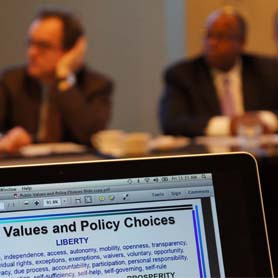Supporting Educators in Demographically Changing Suburban Schools and Districts
 Bloomington, MN – On February 3, 2012, One Nation Indivisible brought together educational leaders, scholars and policy experts to explore the implications of demographic change in suburban communities and consider the most effective ways to create welcoming, equitable, high quality, racially and culturally integrated public schools. Educational leaders from across the nation talked about recent responses to demographic change within their school districts. Such responses included plans that reduce and prevent racial and economic segregation, efforts to increase cultural competency among administrators, teachers and other school employees and initiatives that more fully bring the perspectives of families and students of color to bear on school policy, programming and curriculum. Leaders also discussed the mix of positive and negative reactions that surface in racially changing communities and within local political contexts. Scholars and policy experts led discussions about how public leaders, elected officials and government could best support public school educators who are working toward welcoming, equitable, effective and racially and economically diverse schools. The meeting was the first of several “strategy sessions” that One Nation Indivisible will organize this year.
Bloomington, MN – On February 3, 2012, One Nation Indivisible brought together educational leaders, scholars and policy experts to explore the implications of demographic change in suburban communities and consider the most effective ways to create welcoming, equitable, high quality, racially and culturally integrated public schools. Educational leaders from across the nation talked about recent responses to demographic change within their school districts. Such responses included plans that reduce and prevent racial and economic segregation, efforts to increase cultural competency among administrators, teachers and other school employees and initiatives that more fully bring the perspectives of families and students of color to bear on school policy, programming and curriculum. Leaders also discussed the mix of positive and negative reactions that surface in racially changing communities and within local political contexts. Scholars and policy experts led discussions about how public leaders, elected officials and government could best support public school educators who are working toward welcoming, equitable, effective and racially and economically diverse schools. The meeting was the first of several “strategy sessions” that One Nation Indivisible will organize this year.
Strategy session participants, working in collaboration with other scholars and educators, will soon release recommendations and proposed actions for policymakers and practitioners at the local, state and national levels. Our hope is that this document will inform discourse, policy and programming in and provide much needed support to educators on the ground in racially and culturally changing communities.
This knowledge sharing and action planning comes at a crucial time for our rapidly changing nation. Because of immigration to the United States and out-migration from urban areas, more than half of Asians, Latinos and African Americans now live in suburbs. According to the demographer William Fry, the share of African Americans living in the suburbs of large metropolitan areas rose from 37 percent in 1990 to 51 percent in 2010. That year, about 62 percent of Asians and 59 percent of Latinos in large metros live in suburbs, as do about 78 percent of whites.
If you are interested in learning more about the outcomes of this meeting, please contact us.
Related Resources
- Read our write-up about this strategy session
- Read Building Support for Educators in Racially Changing Suburbs, issued by the National Coalition on School Diversity (2011)
- Read America’s Racially Diverse Suburbs: Opportunities and Challenges by Myron Orfield and Thomas Luce (2012)
 AndPlus
AndPlus